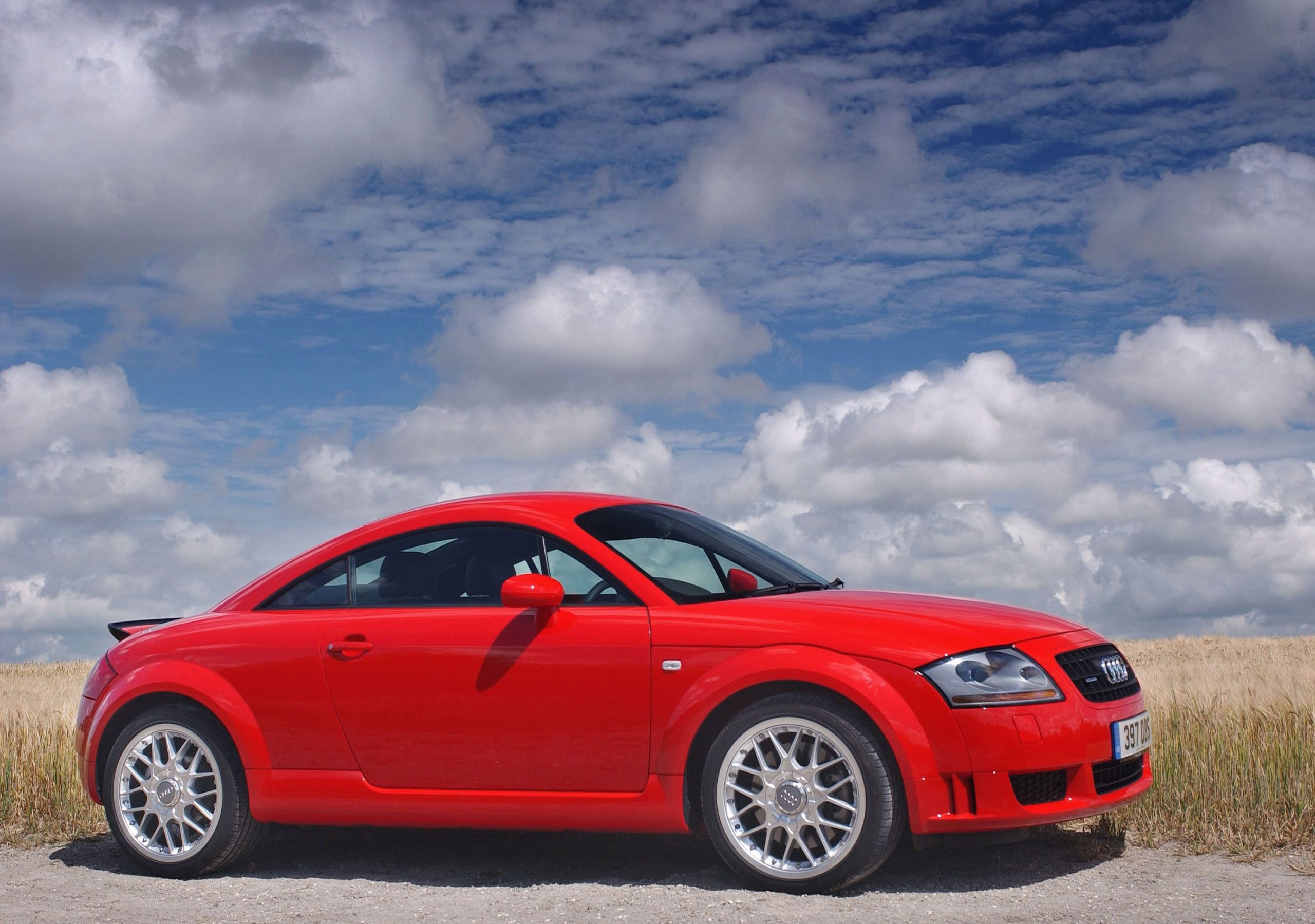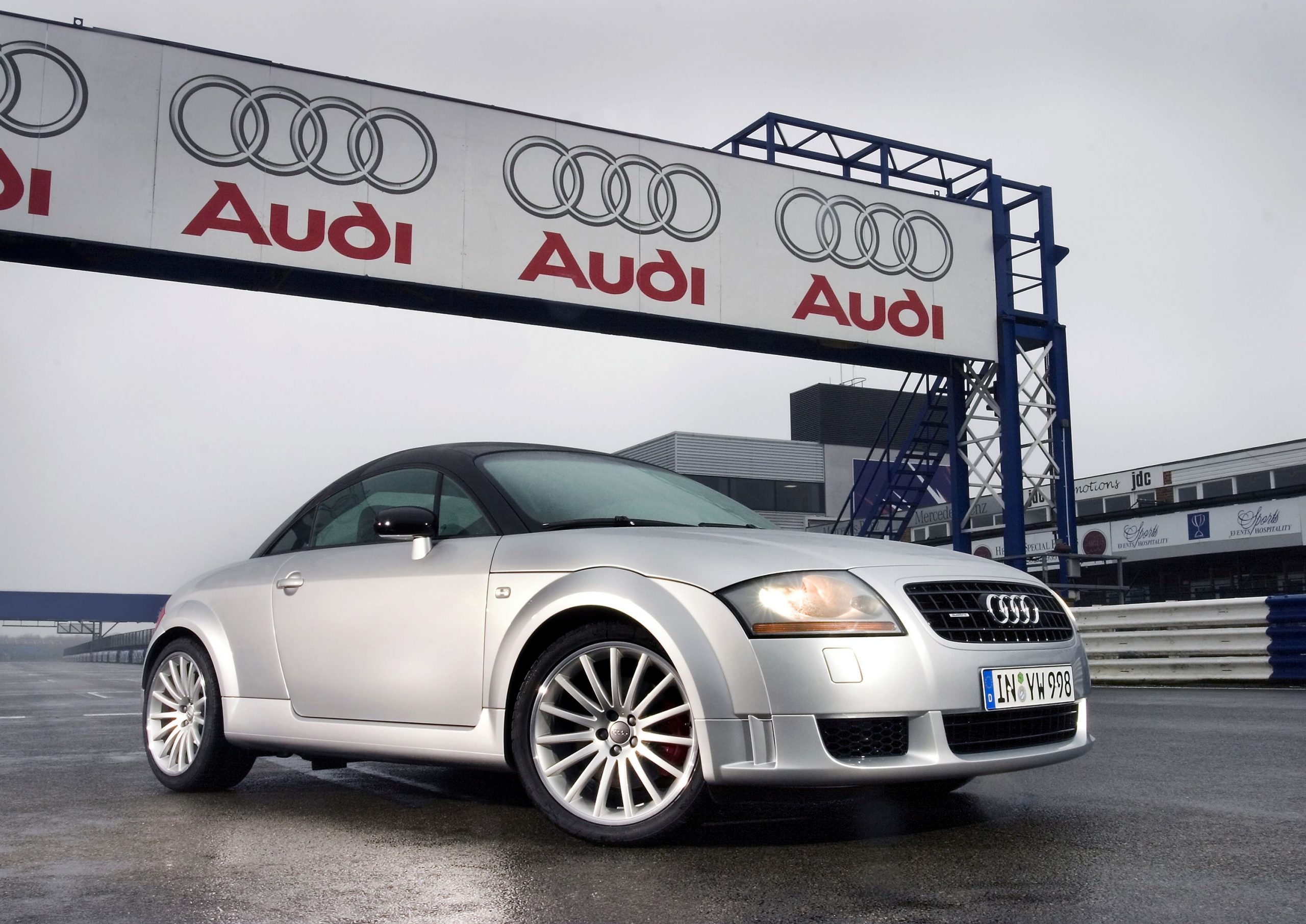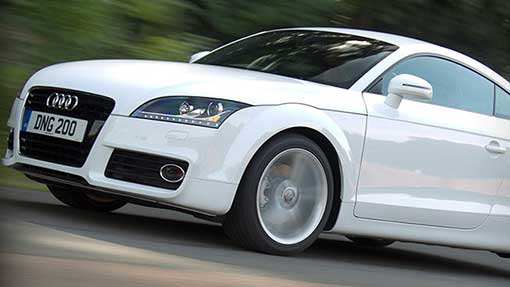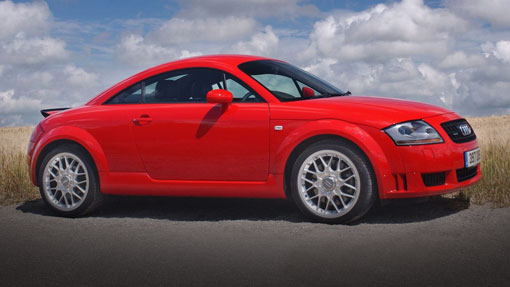BUYER’S GUIDE
Audi TT (Mk1/8N) Review
Later generations of the Audi TT got faster and more luxurious but in style terms the original is arguably still the best
Engine
1.8-litre four-cylinder petrol, turbocharged
Power
225PS (165kW) @ 5,900rpm
Torque
280Nm (206lb ft) @ 2,200rpm
Kerb weight
1,465kg
0-62mph
6.6 seconds
What Is It?
One of the most distinctive slices of modern car design, the TT may have been based on generic VW underpinnings but genuinely looked like nothing else. Referencing everything from Bauhaus and Fritz Lang’s Metropolis through to Audi racing and concept cars, the TT’s bold lines combined style and sophisticated production processes to great effect. Turbocharged engines and Quattro all-wheel drive meanwhile drew a link to Audi’s technical traditions and previous motorsport successes, signature options like the ‘baseball’ leather upholstery showing a playful side as well. Some of its rivals may have offered a more traditional sporting drive but the TT’s combination of style, usability and quality were a statement of intent for turn of the millennium Audi the brand still lives by today. A true modern classic, then, and still an affordable one to boot.
Corrosive Areas
Inner wings
Roof rails
Sills and underfloor seams
Checklist
- Following 1998 unveiling Audi TT launched in the UK in 1999 with 180PS (132kW) and 225PS (165kW) versions of the same 1.8-litre turbocharged engine and the Quattro-branded all-wheel drive system
- Lower-powered models distinguished by the single exhaust outlet and a five- rather than six-speed manual gearbox; 180PS (132kW) versions upgraded to the six-speed from 2000-onwards
- Roadster version followed soon after
- 2003 saw various additions to the range, including more affordable 150PS (110kW) and 180PS (132kW) versions, both with front-wheel drive; at the other end of the scale a new 250PS (184kW) 3.2-litre V6 introduced the then-new dual-clutch ‘DSG’ gearbox
- 2005 versions of the lower-powered models received a power boost, going to 163PS (120kW) and 190PS (140kW)
- Desirable Quattro Sport version also launched in 2005, with a 240PS (177kW) version of the four-cylinder engine, Recaro seats up front and rear ones deleted, signature alloy wheels and two-tone paint with a black roof
- 8-litre engines generally reliable when looked after properly, with regular oil changes and adherence to cambelt service intervals; reports vary but for safety’s sake this should be done every six years or 60,000 miles along with the tensioners and replacement water pump with sturdier metal impeller
- If there’s no evidence of this having been done recently budget to have this carried out on any new purchase; also check under the plastic engine cover for any sign of oil leaks, cracked pipes or broken connectors that may spell trouble; the 1.8 is easily tuned so beware remaps or signs of a hard life
- V6 engines are generally sturdy with correct maintenance but cam chains can stretch (listen for rattles) and replacement is an expensive job
- Haldex all-wheel drive units on Quattro require oil changes every 20,000 miles, while DSG gearboxes require the same every 40,000 miles – check for evidence of this when going through receipts and service history
- Failing instrument clusters a common issue – look out for ‘missing pixels’ and inaccurate fuel and temperature measurements; specialists can recondition to working order
- Although still relatively fresh corrosion can take hold in the roof rails, while dirt collected at trailing edge of sill trims and under wheelarch liners can trap moisture; check panel gaps (especially along complex bonnet edge) for signs of crash repairs
- Failing window microswitches can cause issues – the frameless glass should drop and then reseal when the door is closed
How Does It Drive?
The Golf foundations and front-wheel drive origins mean the TT will never trouble a Porsche Boxster or Honda S2000 in the dynamic stakes, but that’s not to say it isn’t fun to drive. Compared with later versions there’s a straightforward, mechanical connection and meaningful feel to the controls while the 1.8-litre engine, especially in its more powerful tuning, has a gutsy and entertainingly boosty power delivery that rewards revs. Punchy acceleration and sure-footed, all-weather handling on the Quattro models is also satisfying and easy to appreciate in everyday driving situations, and a well-sorted TT should be as entertaining to drive as it is good to look at. The lighter and more powerful Quattro Sport does all this but more so, the gorgeous Recaro seats gripping you tightly through the corners while the 240PS (177kW) tune of the engine pulls with real vigour. The 3.2-litre naturally aspirated V6 is a different experience, the more tuneful exhaust note, smoother power delivery and then revolutionary DSG gearbox helping compensate for the sense it’s a little heavier on the nose than the 1.8s.
What’s Good?

Looks are going to be the primary attraction with the TT and the good news is these are maturing very nicely indeed, and just as striking as they were when the car first arrived in the late 90s. There’s a purity and precision in this first-shape TT Audi never quite matched in the later ones, the earlier models with their cleaner lines and the signature six-spoke alloy wheels perhaps still the most attractive. If you can find one of these with the exotic looking ‘baseball’ interior you’ve landed a bona fide automotive design classic, and a car worth holding onto.
Shared parts with other models in the Audi and VW ranges might count against it in the eyes of sports car snobs but it also means a huge amount of knowledge in how to make the cars go faster and handle better if that’s your bag, shared parts meaning availability and cost of spares is kept more manageable than exotic alternatives. Credit to the design that it also survives transition into the Roadster version without losing any appeal whatsoever, meaning there’s no need to be embarrassed by preferring the soft-top.
What’s Bad?
In addressing early handling wobbles that famously ended in some very serious high-speed crashes on the German autobahn Audi arguably dulled the TT’s handling somewhat, the rear lip spoiler detracting from the otherwise pure lines while measures to calm the pointy steering also dumb things down somewhat. Some of these modifications can apparently be ‘undone’ with tweaks to front bushings to improve steering feel but the TT will always carry a whiff of style over content among some purists.
While generally well-made and sturdy there are some known issues to consider when looking at TTs, and working your way through the large numbers still on sale to find the actually desirable examples can be dispiriting. There’s also the fact they’ve been relatively cheap to buy for a while now, so may have been through as succession of owners more interested in the looks than staying on top of the maintenance required to keep them sweet.
Which Model To Choose?

All first-generation TTs look good, so the same sense of style remains whichever one you go for. The lower powered front-wheel drive ones may prove a little lacklustre to drive, but a later version with the uprated 190PS output could prove cheaper to buy and not far off the pace of the heavier Quattro versions. Given these default to front-wheel drive in most situations anyway you’ll not be losing much in performance or handling pizzazz, either. Saying that it’s still an Audi, and the paired exhausts, extra performance and the Quattro badge of the 225PS (165kW) 1.8-litre version carry additional cachet and definitely make more sense of the overall package. While rare the Quattro Sports are coveted for their extra performance, beefed up looks and genuinely special vibe of the improved interior, so could be worth holding out and paying a little more for. V6s are perhaps less sharp to drive, but the junior GT vibe has appeal of its own and, with a Roadster, you’ll be able to appreciate the more sophisticated engine note all the more with the roof down.
Specifications
Engine
1.8-litre four-cylinder petrol, turbocharged
Power
225PS (165kW) @ 5,900rpm
Torque
280Nm (206lb ft) @ 2,200rpm
Transmission
Six-speed manual, all-wheel drive
Kerb weight
1,465kg
0-62mph
6.6 seconds
Top speed
151mph
Production dates
1998-2006 (total production, all models)
Get an online quote in minutes or call us
Monday to Friday from 09:00 - 19:00
Saturday from 09:00 - 14:00
Sunday from 10:00 - 14:00
or Arrange a call back.
Get an Online Quote Now
Arrange a Call Back
win a year's car insurance

Audi TT Mk2
BUYER’S GUIDE
Audi TT Mk2 Review
The Audi TT Mk2 combines advanced tech with broader appeal and improved performance…
Manufactured
2006 to 2014
Fuel Type
Petrol
Engine Sizes
2,000cc
Engine Type
Turbocharged
Drive Configuration
AWD
What Is It?
What the second-generation, Mk2 Audi TT may lack in design purity compared with the original it more than makes up for in performance, technology and the range of different models you can choose from.
Launched in 2006, the ‘8J’ TT (to use the internal designation) adapted the pioneering Audi Space Frame aluminium construction techniques developed for the A8 and A2 into a hybrid mix of this and conventional steel panels, other distinguishing features including a pop-up spoiler to replace the fixed one introduced to first-gen cars to counter initial instability. While still based on a generic VW platform this helps counter the argument the TT is simply a Golf in posh clothes, Audi targeting the use of aluminium in the panels to offset the natural nose-heavy balance of the front-driven foundations.
Over its lifespan the 8J TT introduced a number of new powertrains and model lines to the range as well, including diesels, a sporting S version and, most excitingly, the return of Audi’s signature five-cylinder turbo in the top of the range RS. Front-wheel drive or quattro, manual or dual-clutch auto, Coupe or Roadster, there’s a huge range to choose from with the second-gen TT. Here’s how to pick the right one.
Checklist
- While generally well-proven the control unit on the S tronic dual-clutch automatic gearbox can fail, and is an expensive fix – check for smooth shifts by coming on and off the throttle at slow speeds and make sure the gearbox keeps up
- The aluminium panels at the front of the car can be more expensive and difficult to repair, so don’t gloss over any minor dings or imperfections you may encounter
- TTs are a great everyday sporting coupe but that means many will have had hard lives – check for kerbed wheels, stone chips, cheap repairs and underbody corrosion
- On Roadsters make sure the powered roof operates as it should, the trim panels it folds beneath close properly and there are no leaks – check for damp carpets in the cabin and boot
- Electric window regulators can fail; check for smooth operation and beware of any odd noises, though failure can occur without prior warning
- The 211PS version of the 2.0-litre TFSI introduced for the 2011 model year is actually a newer generation of engine (known as EA888) compared with the EA113 2.0-litre on earlier cars, and uses a chain-driven cam rather than the belt of the previous engine – better in theory as you don’t need to change it but tensioners can fail and are as catastrophic as a snapped belt
- Owners report TTs can get through their tyres pretty quickly, which could get expensive for those optioned up with bigger wheels, especially if you are doing the right thing and opting for quality branded rubber – cheap or mismatched tyres on a potential purchase suggest an owner unwilling to invest in proper care
- S line models had standard Sports Suspension with 10mm lower ride height; optional Audi Magnetic Ride has the same but may be more desirable for the ability to run the dampers in the softer mode – some contemporary reviews criticised the Sport settings for having a harsh ride so consider this and the wheel size if comfort is important
- Recalls to be aware of and should have been addressed already include one in March 2008 for revised side pillar trim to replace original pieces that could intrude on the interior if the seat belt tensioners deploy, another in July 2009 for faulty vacuum pipes on the brake servo and one in September 2009 for the control unit on S tronic gearboxes after it was found mis-reading temperature sensors could open the clutches and result in loss of drive
- Like the appearance of the RS but can’t stretch to the price? The Amplified Black Package introduced as an option on 2013 models adds the fixed rear spoiler and 19-inch ‘Rotor’ wheels for a similar look – going the other way if you like the RS but it’s a bit shouty there was a factory delete option for the wing
How Does It Drive?
For driving purists there is no escaping the TT’s front-driven roots compromise it dynamically compared with the classically rear-driven BMW Z4 or mid-engined purity of a Porsche Boxster or Cayman. But nobody ever accused modern hot hatches of being boring to drive, and Audi knew how to play to its strengths and mitigate any apparent weaknesses in the layout.
With over two-thirds of the panels made from aluminium the weight distribution on the coupe is pretty much 60:40 front to rear depending on the version, lightweight suspension parts and other thoughtful engineering contriving a feel at the wheel that’s even lighter than the figures suggest. True, at the limit a TT will push on. But at the speeds you can drive on the road it feels nimble, pointy and fun, while the quattro versions have the reassurance of all-weather traction and ability to use more of the power more of the time than you might in that Z4 or Cayman.
While the temptations of the charismatic five-cylinder in the RS are obvious it’s perhaps a blunter instrument than the four-cylinder petrol models, the later 2.0 TFSI or S both sweetly balanced.
What’s Good?
The 8J TT hails from a high point for Audi interiors, and the feelgood factor of its crisp design and quality materials isn’t to be underestimated. Obviously this only improves with higher-spec examples, so ideally you’ll be seeking out S line or similarly high grade models as you filter your search and, by the time you reach the full S version, the combination of leather, Alcantara and other luxury materials feels as good as it looks.
OK, it’s perhaps a little less characterful than the first-gen TT. But still a nice place to spend time. Performance and refinement are also good, and there are plenty of engine options to choose from according to your tastes, budget and driving style. While front-wheel drive versions shouldn’t be dismissed out-of-hand the all-wheel drive quattro variants have that core Audi USP and mean all-weather capability lacking in most rivals.
Similarly, the market likely favours the S tronic gearbox, and the original TT was the first to market with a dual-clutch gearbox so has a claim to it as a trademark feature. But the manual is lighter on the nose, nice to use and adds a level of involvement keen drivers will appreciate. Each to theirs but we’d take that over a couple of tenths off the 0-62 time.
What’s Bad?
In-car tech has come on leaps and bounds in the last decade and, while Audi has always been ahead of the game here, there’s no escaping the small nav screen and fiddly controls age the car more than the styling or performance, especially compared with the nifty Virtual Cockpit introduced on the third-gen TT.
In some ways finding a non-nav car and installing a phone holder to navigate off your apps may be a neater solution. In terms of things to look for these are still relatively new cars in the market but with that come the issues you’d encounter with any mainstream purchase. That means cars that may have passed through several owners on finance, or without too much emotional stake in upkeep. So look carefully at the history, be wary of ‘tells’ like cheap or mismatched tyres and obvious things like kerbed wheels, stone chips or other evidence of a hard life.
Make sure everything works as it should and be aware of common issues like dodgy S tronic gearboxes (test drive with care and make sure there are no lurches, clunks or kangarooing at low speeds) or leaking hoods on Roadsters. There are enough in the market that you can afford to be picky, so having settled on an engine and spec employ due diligence and insist on one whose history looks solid.
Which Model To Choose?
While adequate the basic front-wheel drive 160PS (118kW) 1.8 petrol is probably the least desirable here, the 2.0-litre petrol versions good all-rounders with hot-hatch levels of performance in standard 200PS (147kW) and later 211PS (155kW) trim, while the earlier 250PS (184kW) 3.2-litre V6 and five-cylinder in the RS score for charisma if not running costs. The latter’s 340PS (250kW) – later upgraded to 360PS (265kW) in the Plus version – is seriously impressive and the sound and characteristically turbocharged power delivery add to the fun.
Diesel may carry a bit of a stigma these days and it’s a quirky option for a sporting coupe but the TDI is fast, economical and could make sense if you do big mileages. If that’s your choice and you’re attempting to claw back credibility among fellow car enthusiasts just point to Audi’s incredible run of Le Mans success with diesel power.
If we had to pick one, though, the TT S looks like the sweet spot. 272PS (200kW) makes it meaningfully fast but, at the same time, it has a deftness lacking in the harder hitting and considerably more expensive RS version. It also gets the best of the interior bits with two-tone upholstery, aluminium trim, the desirable Bose stereo and features optional on other models like the adjustable magnetorheological dampers, meaning less time wasted deliberating over the spec or options.
Specifications
Engine
2.0-litre four-cylinder turbocharged petrol
Power
272PS (200kW) @ 6,000rpm
Torque
350Nm (258lb ft) @ 2,500-5,000rpm
Transmission
Six-speed manual/six-speed dual-clutch auto, all-wheel drive
Kerb weight
1,410kg
0-62mph
5.5 seconds/5.3 seconds (Roadster 5.7/5.5)
Top speed
155mph (limited)
Production dates
2006-2014
